Central Asian Shepherd Information: Breed History, Traits, Care & More
When you purchase through links on our site, we may earn a commission. Here’s how it works.
The Central Asian Shepherd is a massive canine that is also commonly called Alabai or Alabay.This ancient breed has long worked alongside humans as herders and guard dogs. These colossal guardians are intelligent and very independent. This giant, fluffy pooch makes for a loving, loyal companion.
This breed is ancient and made up of many different breeds. The genetic mix has created a giant, loving, proud breed known worldwide. In fact, the Central Asian Shepherd is fast growing in popularity. They experienced the most growth in searches worldwide since 2019. This big, fluffy canine may be the perfect fit for dog lovers that can handle giant breeds. Learn more about this ancient canine breed and how to care for them in our comprehensive guide.
Remember, all dogs are unique. The information we have presented is meant to be a guideline and reference point for owners. Always discuss specific concerns or questions with your veterinarian.
Table of Contents
Breed History
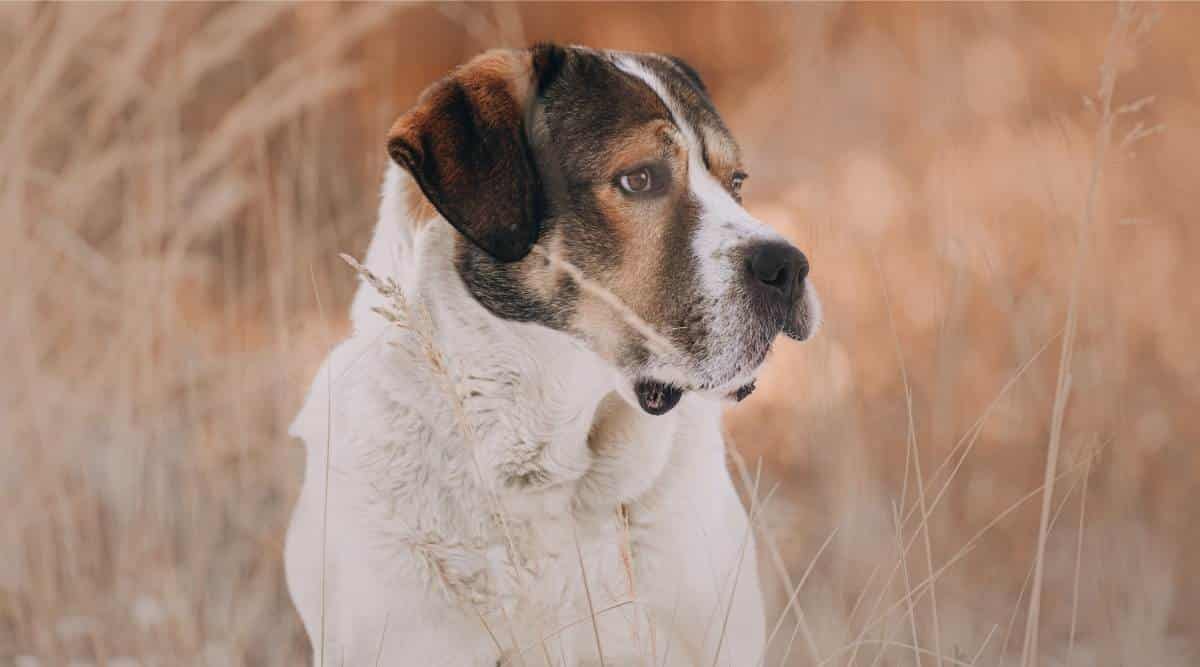
The Central Asian Shepherd (CAS) is an ancient canine breed. Humans did not develop this breed. This canine hails from a vast territory, an area that today includes the Caspian Sea, China, Asia Minor, Southern Ural, and Afghanistan. They can be traced back to ancient Tibet and have a long history in Russia. It is said this breed accompanied Genghis Khan and has been called Mongolian War Dogs.
This breed’s genetic makeup is diverse and can contain traces of many different breeds. This canine blend was formed naturally thousands and thousands of years ago. They were not created or developed by man. This big guy evolved au natural. According to the American Kennel Club, “Their history is merged with the civilization of man, and their timeline can be found by tracing the history of the ancient Silk Road.”
Because the Central Asian Shepherd is so ancient a canine, there is not much known regarding their specific pedigree. Many experts think that the Tibetan Mastiff could be part of the dog’s original parentage. Because this dog has been around for thousands of years, it is almost impossible to trace them to one specific breed or place of origin.
The CAS is a huge, muscular, powerful dog. Because of their physical prowess, they were often used as guard dogs for livestock like sheep and goats. Later they became used for personal protection due to their high skill and size. Unfortunately, this big, proud canine was also used as a fighting dog. Sadly, they still are in some parts of the world. Some were explicitly bred for their aggression. Breed lines that descend from these early fighting dogs may be more aggressive. Today this canine breed is listed as a Guardian dog by the American Kennel Club. They are recognized by multiple canine clubs worldwide, including United Kennel Club, the Australian National Kennel Council, North Arkansas Kennel Club, and the Fédération Cynologique Internationale.
The Central Asian Shepherd is called a few other names. This massive canine can also be referred to as Alabai or Alabay. In Russia, they are called the Central Asian Ovcharka or the Volkadov (Wolf Crusher).
Temperament
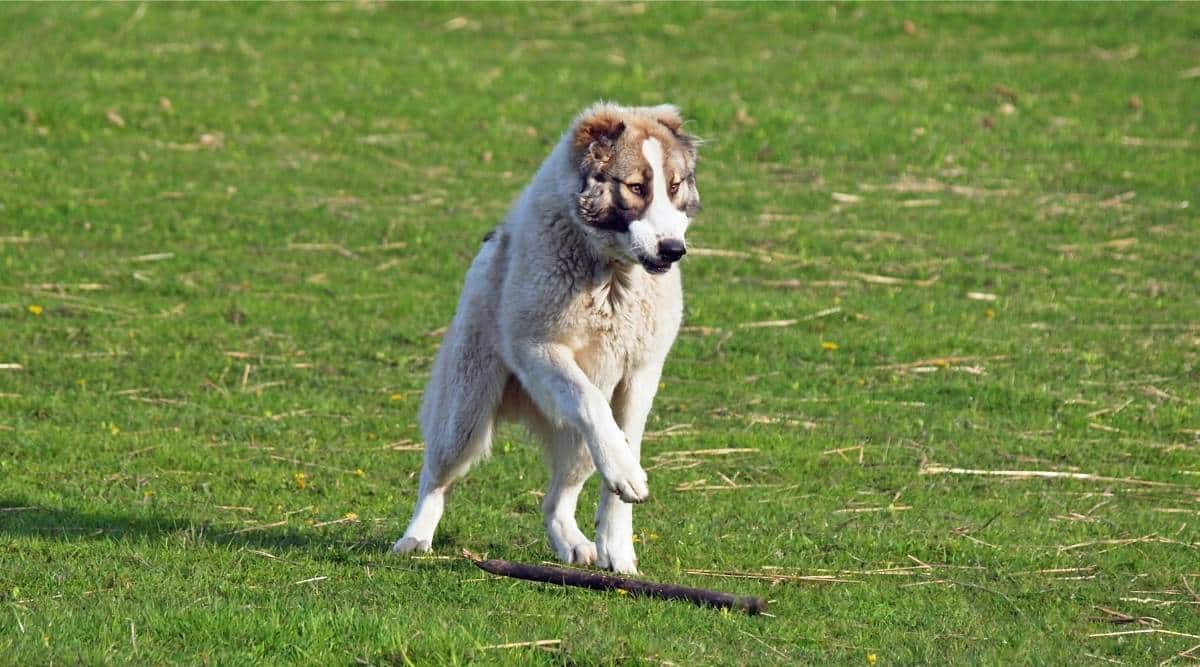
The Central Asian Shepherd dog is a highly courageous pooch known for being independent and very confident. These big dogs are quite loyal and friendly to family members but are not very fond of human strangers. The elegant canine giants are quite friendly and gentle, despite their generous size, with the people they are comfortable with and live with. Along with that, these huge canines are extremely intelligent.
Unlike many other big canines, the CAS does not mind being alone. They truly are dedicated work dogs and can do a lot. These dogs are often found on ranches or farms with livestock. The Alabai can be quite friendly with their human families and get along very well with children and other dogs and livestock.
The CAS is a dedicated, loyal guard pup. Generations of breeding have made them exceptionally good at guarding. They will keep your yard, home, and property well-guarded. This canine is extraordinarily watchful and territorial. They can be standoffish and suspicious of new people, particularly those who enter their territory without warning.
These huge guard dogs are highly adaptable and regularly active canine companions. This makes them fantastic walking and hiking buddies. They have a lot of stamina and endurance and genuinely enjoy exercise. This big guy does well in most climates. He is a canine that can tolerate both cold and hot climates easily.
Overall, this canine has been described as a calm dog that enjoys physical activity and loves to play. They like attention from people but are not clingy or needy. While they like being around people and will follow owners around, they are also perfectly content with being left alone to sleep the afternoon away.
This big pup is curious and quite confident in his own abilities. They like to wander off and are not safe dogs to leave off a leash around other dogs. They are particularly good at finding ways to escape, so it is a good idea to make sure you have a well-fenced yard with no breaks or open spots where they can escape from.
Bark
The Alabai has an impressive bark. They are not overly vocal dogs, but when this breed has something to say, they say it LOUDLY. Their bark is described as booming, and they will let everyone know when someone unfamiliar shows up. This canine’s jaws are enormous and have a bite force of 500 to 650 pounds per square inch. A CAS’s bite is as impressive as its bark. These big guys may make it awkward for delivery people. Posting a sign or having a designated drop-off spot may be good to avoid unwanted confrontation or a reluctant delivery person.
Size And Appearance
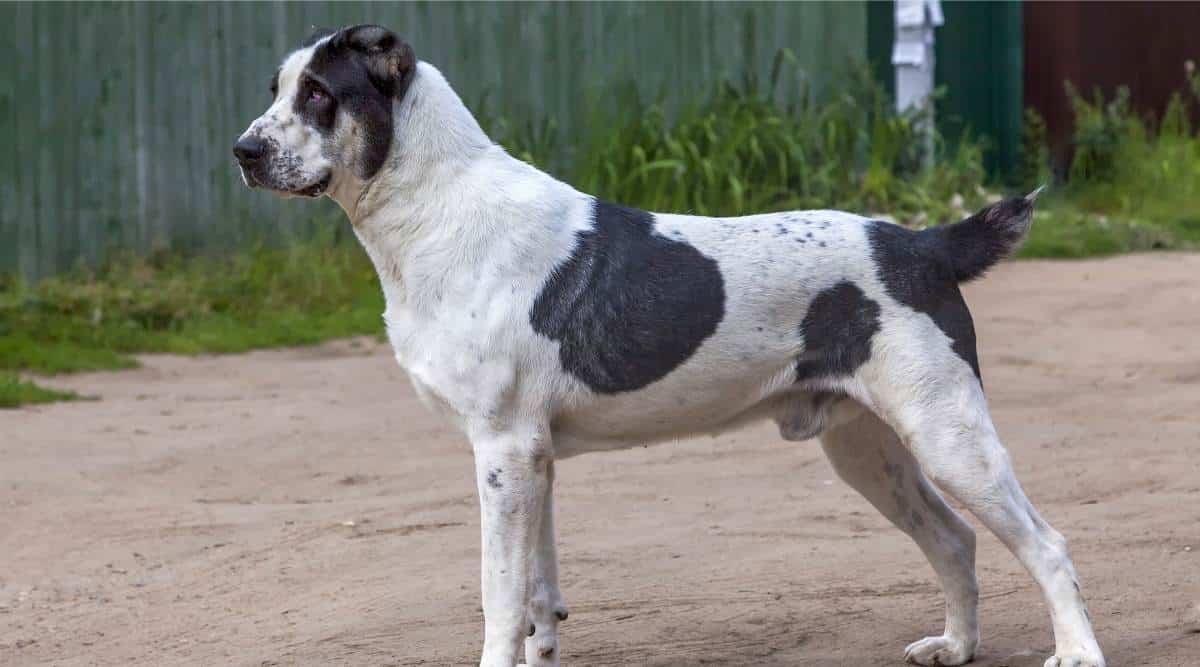
Fully grown, they weigh a minimum of 88 to 110 pounds. It is not unusual for a full-grown male to reach over 175 pounds. The CAS has no known maximum size and can reach giant size. They stand 24 to 28 inches tall from paw to shoulder. This canine has a longer than average lifespan and lives from 12 to 15 years. Males are significantly larger than females, and they will weigh more and stand taller.
These loyal canine guardians are big in every sense of the word, from paw size to personality. They have large bodies with large rectangular heads. This huge dog has large, oval-shaped eyes that are deep-set. Their eyes can vary in color from amber to deep brown. They usually are black-rimmed. They also have noticeably thick eyelids.
Ear Cropping & Tail Docking
This canine naturally has thick oval-shaped ears that hang down the sides of their faces. Typically, their ears will be cropped, and their tails docked when these dogs are incredibly young. Both ear cropping and tail docking are controversial procedures. According to the American Veterinary Medical Association, there is no known or proven health benefit to dogs for either of these practices. Despite both practices being controversial, and there are no known health benefits to the dogs, it is quite rare to find an uncropped Central Asian Shepherd.
Ear cropping was historically done with this breed as they were often used in fighting, and even guard dogs would encounter predators. Cropping the ears prevented them from getting shredded or hurt in a fight. Tails were historically docked in the breed for the same reason. As livestock guardians, the dogs were often at risk of being attacked by wild animals. Docking the tail prevented the dogs from getting injured or surprised by a coyote, badger, fox, or other common predator biting their tails. Today’s breeders continue these practices to maintain the Central Asian Shepherd breed standard and keep their unique appearance close to that of the dog’s ancient relatives.
Coat And Colors
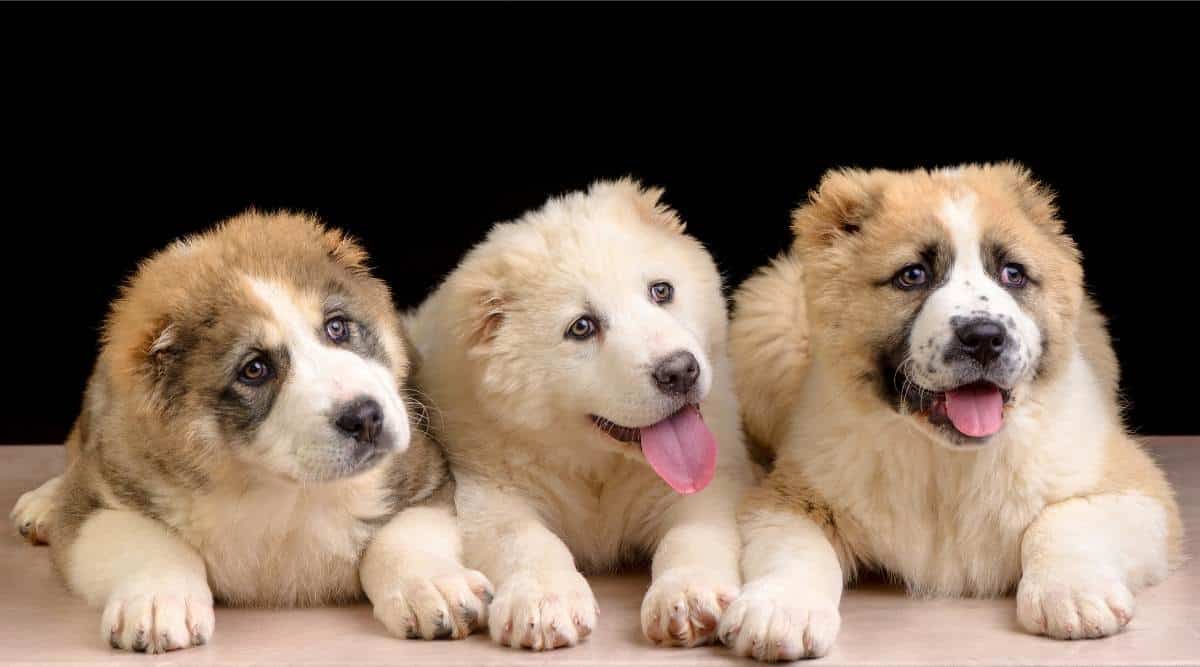
Central Asian Shepherds sport a medium-length dense coat. Some may have shorter coats, and some may have very long-haired coats. They come in various colors, with the most common being black, white, brown, fawn, gray, and brindle. Often, they will have white, tan, or brown markings.
The Alabai has a lot of hair. Their coats, like most other dogs, can change with the seasons. During the summer, their coats are thinner. In chilly weather, they will fill in a thicker undercoat. Once a year, these canines will have a big shed. This has been aptly called the “fur storm,” which is no exaggeration. When they shed, there will be fur everywhere and loads of it. Owners should be prepared for there to be a lot of hair around if they have one of these dogs. Investing in a high-quality vacuum and a lot of lint rollers is a good idea.
Exercise Requirements
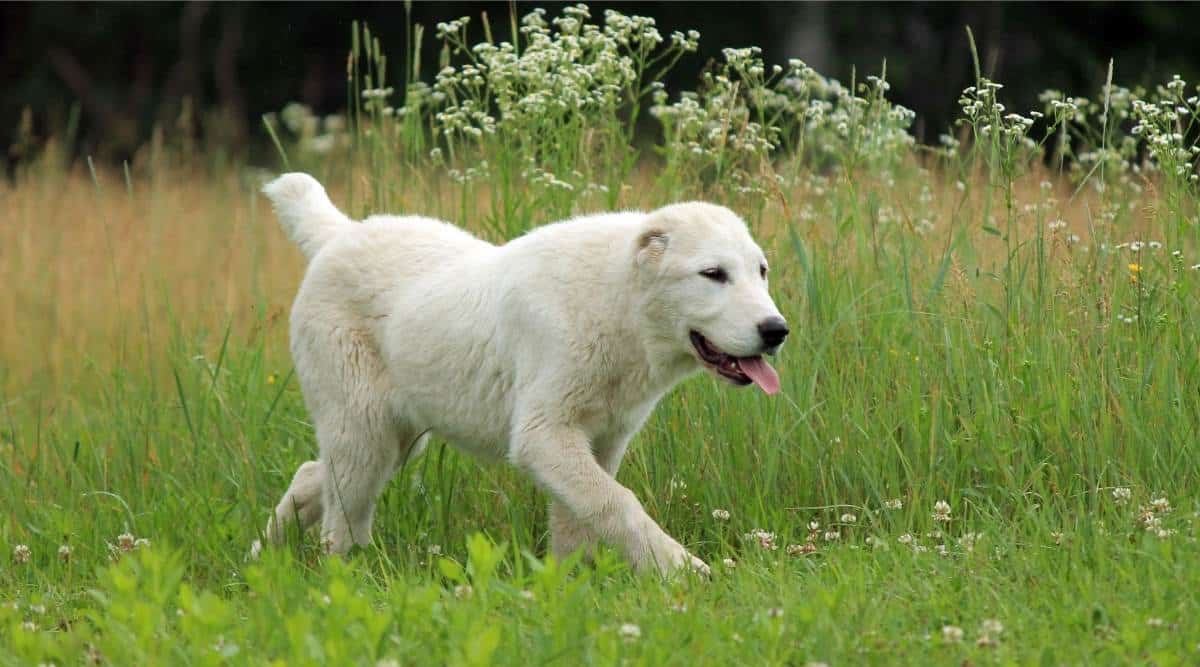
They are quite agile and have a lot of endurance, but that does not mean they can go on forever. In fact, it can be easy to overexert this breed because they love to be active. On a nice long hike with their favorite person, they certainly will not complain or let you know that they are tired. This breed was bred to work hard for an extended period. Their bodies can handle physical activity and strenuous exercise.
These dogs need regular daily walks. Without this outlet for their energy and physical and mental stimulation, they can become bored and unhappy.
On average, about an hour of exercise a day is required for the Alabai. They love to walk and hike, even if it is just around the neighborhood. They can go on long walks or hikes. Just make sure to have plenty of water and allow them time to rest. Carrying around their big bodies is a lot of work, and these dogs can get overexerted or tired quickly, especially in the heat.
Living Conditions
The majestic Alabai is a dog that needs room. His sheer size means he is not a great breed for someone who lives in an apartment or a tiny house without a yard. While some may say this breed can stay healthy and content in an apartment, that is not the case.
These colossal canines need a home with room and freedom to explore. They can be socialized to have a good relationship with other dogs and animals but may do best in households where they are the only pets.
This dog needs an owner with patience and a place to be safe. They love to chase small animals and like to escape. They need a lot of entertainment and interaction to keep them from getting bored.
Training
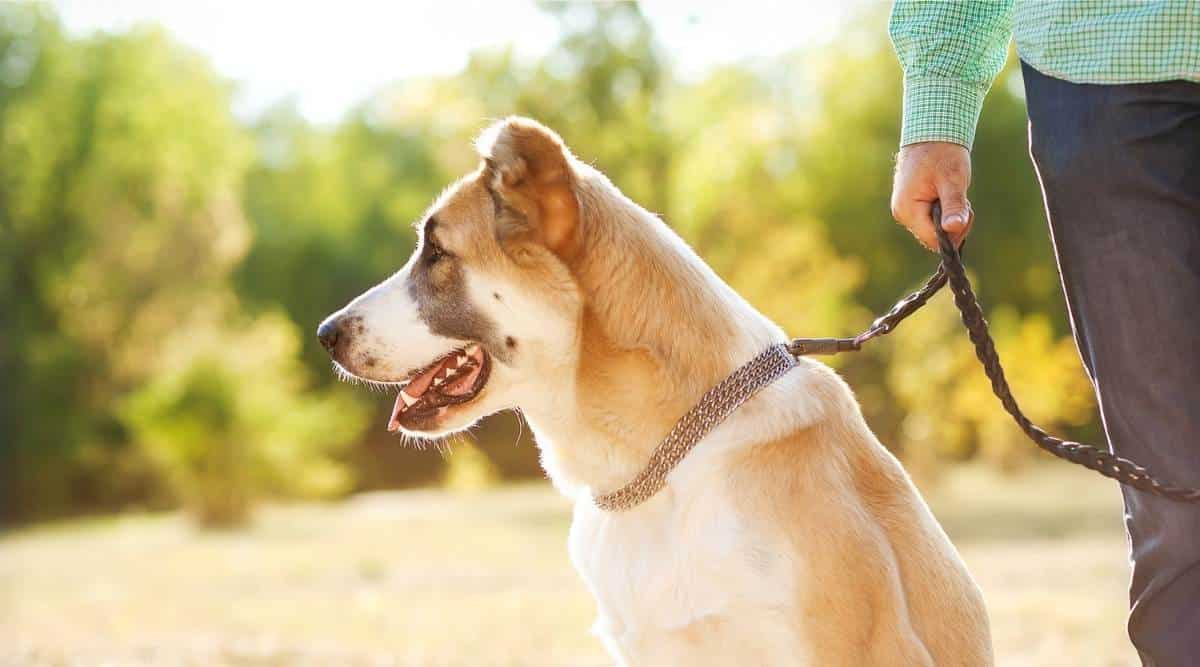
Central Asian Shepherds are brilliant dogs. Because of this, they can be both easy and challenging to train. These dogs were bred for obedience and, once taught, do very well. Owners must establish themselves as the pack leader or the alpha dog to successfully train this canine.
The training process can be challenging with this breed. They do not like to be yelled at. They respond more effectively to positive reinforcement. This breed can benefit from professional training and behavior classes.
Because this breed is naturally protective and alert, they are always on guard. This can be an issue with other dogs and people if they are not socialized at a very young age. Regular interaction with other people and animals starting when they are puppies will help. Always supervise these dogs with other canines and especially with small children. Due to their massive size and independent streak, they should always be supervised around children.
Health
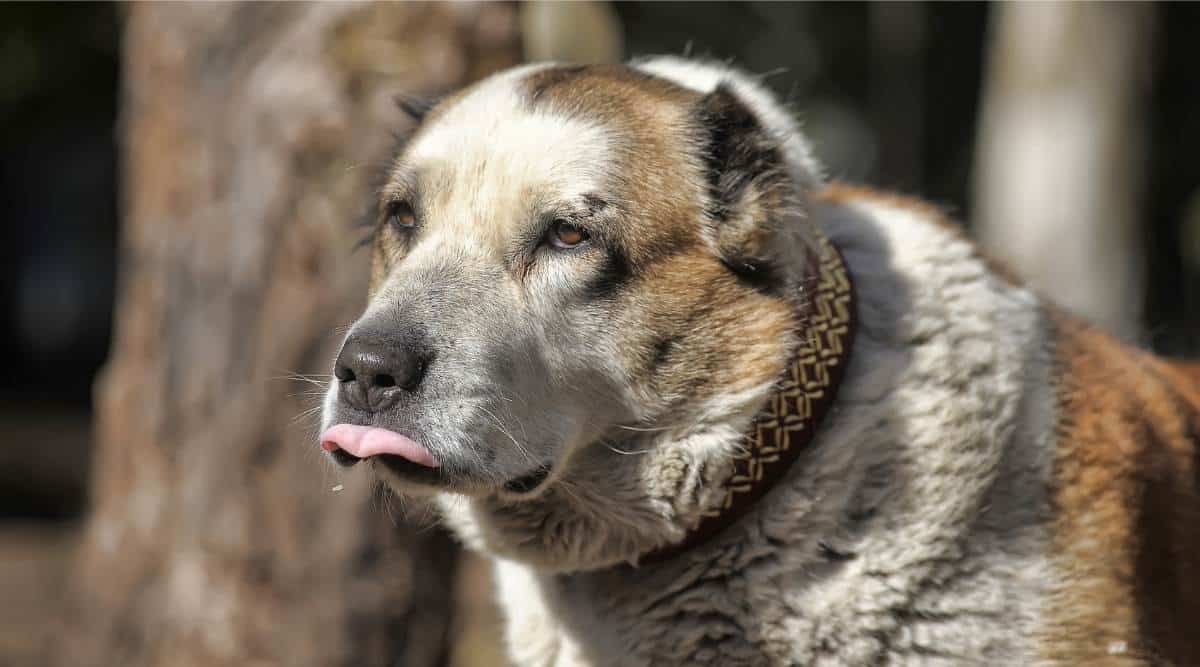
Some have even lived up to 17 or so years. They are not predisposed to as many inherited genetic conditions as many other large breeds. They can develop hip and elbow dysplasia. The only other major health concern this breed has is that they can develop epidermolysis bullosa, an uncomfortable, blistering skin condition. This is rare but is something to watch for with these big dogs.
As with all big dogs, obesity can be a problem for the Alabai. Carrying around such a large amount of bulk can stress out joints, leading to issues later in life. Arthritis, vision issues, hypothyroidism, and other age-related health concerns may arise. This dog will need regular checkups. Make sure to follow your vet’s guidelines as far as supplements and additives that your dog may need for bone and joint health. Always discuss any health concerns in a large breed like the Alabai as soon as they become noticeable. This may be a breed that is worth investing in health insurance for. They can be quite costly to care for, and pet insurance can be extremely helpful in an emergency or serious medical situation.
Nutrition
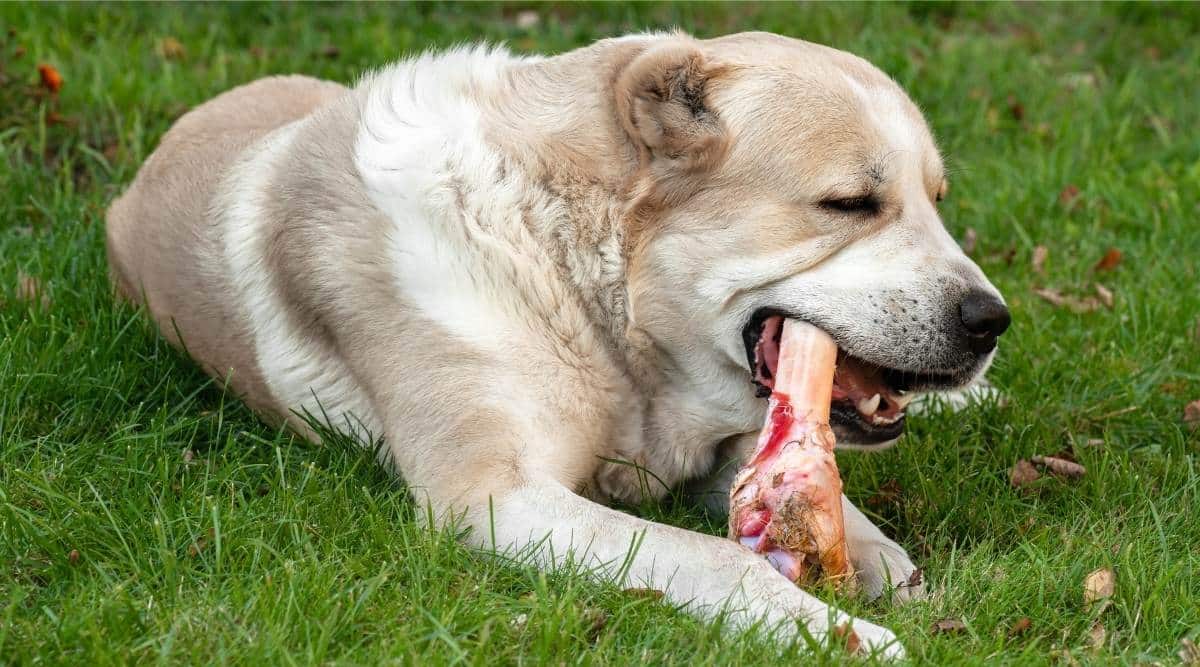
Because of their size, they need a high-calorie intake every day. They should be fed food that is formulated for large and extra-large breeds. This huge canine needs a diet high in good protein. About 30% of their diet should be protein from fish, beef, eggs, poultry, wheat, or corn. Some animal proteins are necessary. This helps keep their skin, hair, and muscles healthy. Fat is also needed. Omega-3 and Omega-6 fatty acids should be a part of every dog’s diet.
It is extremely easy to overfeed a big dog. Logically, it seems fitting to feed them a lot. Check with your veterinarian to get an idea of how much your dog should eat. This can fluctuate depending on size. One large meal or two small ones may work best for this large breed. All dogs are different, so how often they need to eat varies among the individual dog.
Adding fresh ingredients to an Alabai’s diet can help balance his diet and ensure he gets healthy fats and nutrients. Always discuss this with your veterinarian. Puppies will eat more and require a different nutrient load than older dogs.
Be careful with table scraps and human foods. These are not always easy for dogs to digest and may be high in the wrong kinds of fats. Overfeeding a big breed can lead to obesity, which brings a host of health problems.
Grooming
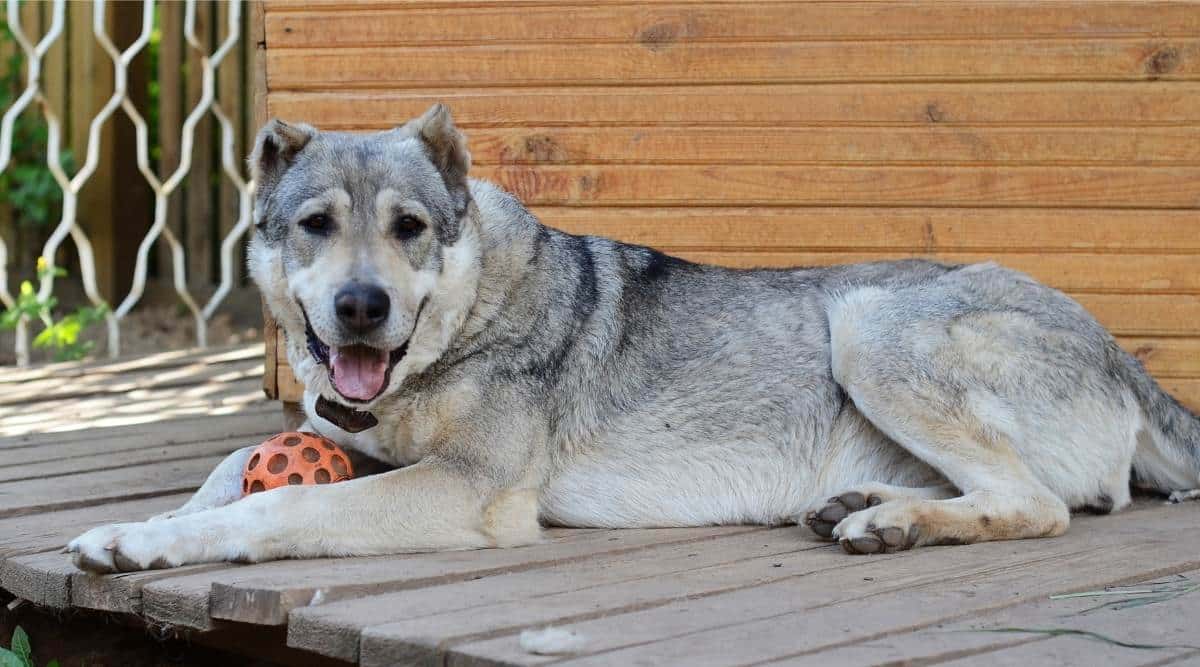
Grooming this bug, furry behemoth may seem intimidating. However, these canines are not as hard to take care of as one might think. Each year, they will experience one great shed in late spring or early summer. When temperatures rise, the hair starts to fall. There is no way to describe this shed other than it is massive. There will be hair everywhere. Expect to need a good amount of vacuuming to control this great shed mess.
A once or twice a week brushing session is enough for the Alabai, though this can depend on the individual dog. A bath here and there may be needed. These pups are quite a handful to bathe. It can be at least a 2-person job. Because they need bathing only a couple of times a year, it may be best just to leave this to the professionals and take him to a groomer. Make sure you always inspect your dog’s nails. This breed may need to have their nails clipped regularly.
Grooming should be a bonding time for you and your big sweetie. Try to keep this as calm and soothing as possible. Never make him feel cornered or like he has done something wrong. Your dog will need to trust you through this time. Take the effort to make it special, and make sure to be gentle. Never, ever yank a mat out of the Alabai’s fur. This can cause pain and injury.
Breeders & Puppy Costs
The Alabai is an expensive breed to adopt or purchase. Expect to spend at least $1,500 to $2,000 at least. For a high-quality bloodline, the price will be well over $2,000. This price can be higher depending on age, color, vaccination status, and location. Spending $3,000 on a purebred puppy is not unusual.
- Along with the puppy’s price, initial costs will include an oversized crate, collars, leashes, toys, treats, food, grooming supplies, and more. This breed is giant, so they will need more oversized dog items, which often cost more.
- Microchipping, vaccinations, heartworm prevention, flea and tick treatment, and spaying or neutering will also need to be factored in. The first year of this puppy’s life can easily cost an owner $10,000.
- Reputable breeders will always be willing to show pedigree papers and health records. Always ask for these and if you can see the parent dogs before purchasing a puppy. You always want to make sure that the breeder Is not a puppy mill or selling unhealthy dogs. Ask how many litters they have each year.
- More than one or two a year is a warning sign. Responsible breeders will often have clauses in the contracts that ask for the dog to be returned if, for some reason, they cannot stay in the purchaser’s home. Reputable breeders will usually have an application process to ensure their puppies will be with responsible, caring owners. Those looking for a puppy can reference the AKC breeder referral page.
Rescues & Shelters
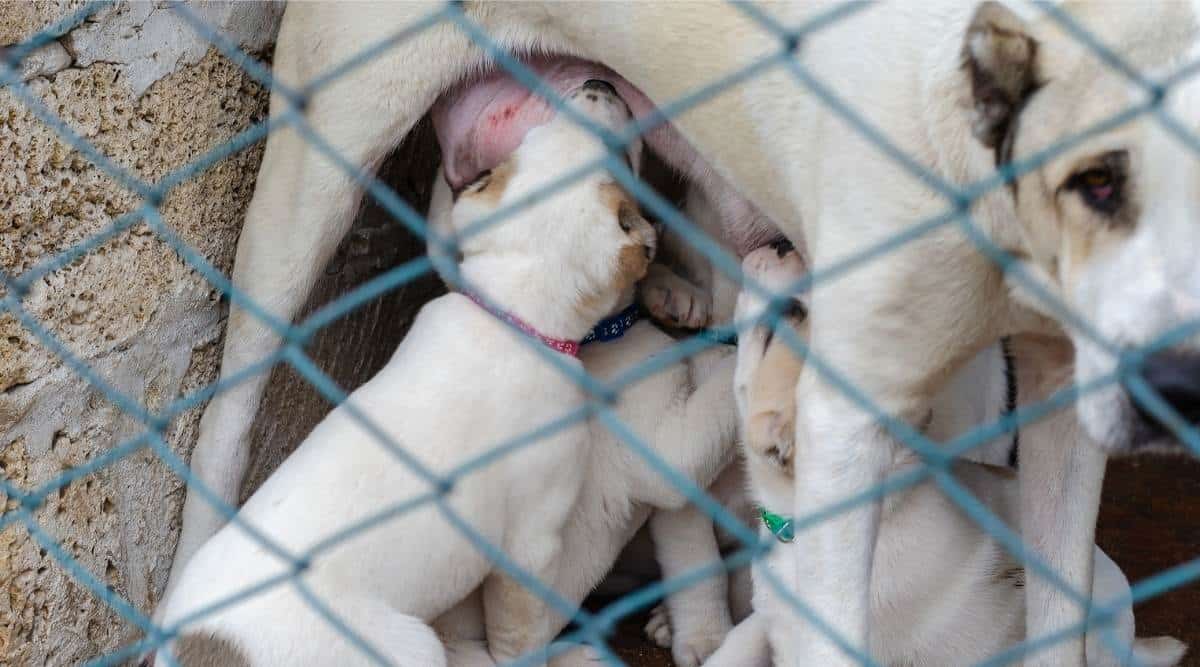
This breed can show up in shelters, often because people may not realize what a commitment they are when they adopt them. At the very least, they can be stressed out and run down from living in shelters or on the streets. Strays may have health conditions like malnutrition, parasites, and infections.
Some large dog rescue groups may be a good place to look if searching specifically for the Alabai. But, be sure to check your local rescue and shelter groups first.
Big Dog Rescues
As Family Pets
The Central Asian Shepherd can be a good family dog in the right circumstances. They fare better as only pets, but this can vary. Some may do fine with other animals, but more aggressive animals may not tolerate them. Training the CAS with other animals around is a huge challenge. Because they are so territorial, they may not be happy about other dogs or small animals being brought into their space.
While this breed is generally friendly around kids, they are huge and not a great breed to have babies or small children around. They also are very suspicious of new people, so if a new person moves in, they can feel threatened. If someone unfamiliar stops by, they will be on guard. Always be around to greet guests and keep signs posted to inform visitors that a big dog lives in the home.
This may not be a desirable choice for first-time dog owners. Owners that have trouble using a firm voice and setting solid boundaries may quickly lose control of this huge dog. Even those experienced with giant, independent breeds should consider obedience classes and professional training for the Alabai. As pet owners, it is our true privilege and immense responsibility to provide the absolute best care, food, training, and medical care throughout a dog’s life.
Final Thoughts
The Alabai is a massive breed of fluffy dog. This breed has been part of human life for thousands of years. While we may never know exactly where they came from, they will be around for a long time to come. This breed is unique in that humans have not developed it. Instead, this breed developed through natural selection and crossbreeding.
The Central Asian Shepherd is a massive dog, not suitable for apartments or small homes. This dog will be a loyal companion for life. They require a lot of care and can be a handful, so they may not be the best choice for inexperienced animal owners. With the right home environment, care, and training, this giant lovable breed can be a good family dog, though they prefer being the only dog in the home. A giant breed like the Alabai is not a dog one will soon forget.



